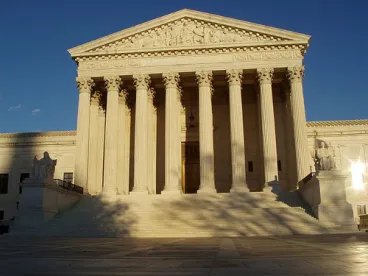On June 8, 2023, the U.S. Supreme Court issued its decision in Jack Daniel’s Properties, Inc. v. VIP Products, LLC and provided some clarity as to the applicability of the “Rogers test,” a doctrine that grapples with the interplay of trademark law and the First Amendment. The case involved a trademark dispute between Jack Daniel’s Properties, the maker of the famous whiskey, and VIP, a dog toy company that makes and sells a product called “Bad Spaniels.” The Bad Spaniels squeaky toy is in the shape of a whiskey bottle and has a black label with white font similar to Jack Daniel’s; in place of “Old No. 7 Brand Tennessee Sour Mash Whiskey,” the toy reads, “The Old No. 2 On Your Tennessee Carpet.” After VIP initially filed suit against Jack Daniel’s seeking declaratory judgment that the product did not infringe on Jack Daniel’s trademarks, Jack Daniel’s brought counterclaims under the Lanham Act for trademark infringement and trademark dilution.
The district court sided with Jack Daniel’s on the infringement claim, but the Ninth Circuit reversed, holding that the district court should have first applied the Rogers test, a threshold inquiry designed to provide First Amendment protection to expressive works that would otherwise be subject to trademark infringement claims. This test, derived from Rogers v. Grimaldi, 875 F.2d 994 (2d Cir. 1989), requires a plaintiff to show that the defendant’s use of the mark (1) “has no artistic relevance to the underlying work” or (2) “explicitly misleads as to the source or the content of the work” before the court can consider the plaintiff’s trademark infringement claim. In the Ninth Circuit’s view, because the Bad Spaniels toy communicates a humorous message, it constitutes an expressive work and thus should have triggered an inquiry by the district court under the Rogers test.
The Supreme Court, in a unanimous opinion, disagreed with the Ninth Circuit. It held that the Rogers test does not apply to such a dispute where the defendant uses the mark as a “source identifier” (i.e., where the usage functions to indicate the source of goods). Instead, the Rogers test is cabined to “non-trademark uses,” or “cases in which the defendant has used the mark at issue in a non-source-identifying way.” To provide an example, the Court drew a distinction between (1) a filmmaker depicting a brand of suitcase to convey something about a character (a non-trademark use, which could potentially warrant the Rogers test) and (2) an upstart luggage manufacturer using a slightly modified version of a well-known brand’s logo to make inroads in the suitcase market (a “trademark use,” to which the test may not apply). The Court reasoned that its holding “reflects [the] primary mission” of the Lanham Act, where the “cardinal sin” is anything that confuses consumers about the source of goods or prevents them from distinguishing among manufacturers.
The Supreme Court also took issue with the Ninth Circuit’s determination that, because the Bad Spaniels toy conveyed a humorous message, it was an expressive work that automatically received the First Amendment protections of the Rogers inquiry. The Supreme Court characterized the Ninth Circuit’s expansive view of Rogers as ultimately not very workable because it “potentially encompasses just about everything”: any combination of names, phrases, symbols and designs can be said to contain expressive content. To assuage any potential concern among lower courts that its decision contravenes the First Amendment, the Supreme Court emphasized the weight of case law recognizing that “trademark law generally prevails over the First Amendment” when a confusingly similar mark is used for source identification.
In addition to clarifying the limited applicability of the Rogers doctrine, the decision also highlights the doctrine’s uncertain future. While the Supreme Court did not decide the issue of whether Rogers has any application at all (the United States, as amicus curiae, sought to abolish the doctrine entirely), the justices signaled that what remains of Rogers is up in the air. Justice Gorsuch wrote a separate concurrence explicitly stating as such, instructing lower courts to be “attuned to . . . the fact” that particular aspects of Rogers remain unresolved.


 />i
/>i
